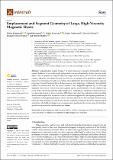Files in this item
Emplacement and segment geometry of large, high-viscosity magmatic sheets
Item metadata
| dc.contributor.author | Schmiedel, Tobias | |
| dc.contributor.author | Burchardt, Steffi | |
| dc.contributor.author | Mattsson, Tobias | |
| dc.contributor.author | Guldstrand, Frank | |
| dc.contributor.author | Galland, Olivier | |
| dc.contributor.author | Palma, Joaquín Octavio | |
| dc.contributor.author | Skogby, Henrik | |
| dc.date.accessioned | 2021-10-18T15:30:17Z | |
| dc.date.available | 2021-10-18T15:30:17Z | |
| dc.date.issued | 2021-10-11 | |
| dc.identifier | 276280463 | |
| dc.identifier | ae0bf7ee-a089-4702-89d9-fe0f9a0ffa81 | |
| dc.identifier | 85116764758 | |
| dc.identifier | 000715252000001 | |
| dc.identifier.citation | Schmiedel , T , Burchardt , S , Mattsson , T , Guldstrand , F , Galland , O , Palma , J O & Skogby , H 2021 , ' Emplacement and segment geometry of large, high-viscosity magmatic sheets ' , Minerals , vol. 11 , no. 10 , e1113 . https://doi.org/10.3390/min11101113 | en |
| dc.identifier.issn | 2075-163X | |
| dc.identifier.other | Jisc: 8adb14fb49a94eb69384df23a79ca737 | |
| dc.identifier.other | ORCID: /0000-0003-0717-4014/work/101582030 | |
| dc.identifier.uri | https://hdl.handle.net/10023/24159 | |
| dc.description | This project and Tobias Schmiedel are funded by the Knut and Alice Wallenberg Foundation through a Wallenberg Academy Fellow grant to Steffi Burchardt (grant No. KAW 2017.0153). | en |
| dc.description.abstract | Understanding magma transport in sheet intrusions is crucial to interpreting volcanic unrest. Studies of dyke emplacement and geometry focus predominantly on low-viscosity, mafic dykes. Here, we present an in-depth study of two high-viscosity dykes (106 Pa·s) in the Chachahuén volcano, Argentina, the Great Dyke and the Sosa Dyke. To quantify dyke geometries, magma flow indicators, and magma viscosity, we combine photogrammetry, microstructural analysis, igneous petrology, Fourier-Transform-Infrared-Spectroscopy, and Anisotropy of Magnetic Susceptibility (AMS). Our results show that the dykes consist of 3 to 8 mappable segments up to 2 km long. Segments often end in a bifurcation, and segment tips are predominantly oval, but elliptical tips occur in the outermost segments of the Great Dyke. Furthermore, variations in host rocks have no observable impact on dyke geometry. AMS fabrics and other flow indicators in the Sosa Dyke show lateral magma flow in contrast to the vertical flow suggested by the segment geometries. A comparison with segment geometries of low-viscosity dykes shows that our high-viscosity dykes follow the same geometrical trend. In fact, the data compilation supports that dyke segment and tip geometries reflect different stages in dyke emplacement, questioning the current usage for final sheet geometries as proxies for emplacement mechanism. | |
| dc.format.extent | 34 | |
| dc.format.extent | 9563975 | |
| dc.language.iso | eng | |
| dc.relation.ispartof | Minerals | en |
| dc.subject | Magma transport | en |
| dc.subject | High-viscosity dykes | en |
| dc.subject | Shallow crust | en |
| dc.subject | Igneous | en |
| dc.subject | Sills | en |
| dc.subject | Chachahuen volcano | en |
| dc.subject | Anisotropy of magnetic susceptibility (AMS) | en |
| dc.subject | Magma flow indicator | en |
| dc.subject | QE Geology | en |
| dc.subject | DAS | en |
| dc.subject.lcc | QE | en |
| dc.title | Emplacement and segment geometry of large, high-viscosity magmatic sheets | en |
| dc.type | Journal article | en |
| dc.contributor.institution | University of St Andrews. School of Earth & Environmental Sciences | en |
| dc.identifier.doi | https://doi.org/10.3390/min11101113 | |
| dc.description.status | Peer reviewed | en |
This item appears in the following Collection(s)
Items in the St Andrews Research Repository are protected by copyright, with all rights reserved, unless otherwise indicated.

